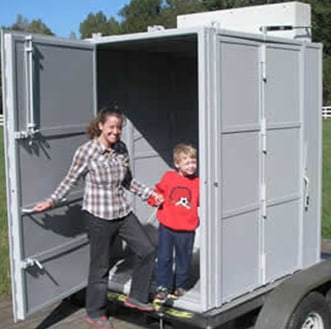The federal government through Department of Homeland Security coined a term “Run, Hide, Fight” as an easily to remember guide to response during an active shooter scenario. This was never intended for elementary or even middle school/junior high school as a viable solution to an active shooter event. “Run, Hide, Fight” is not a plan but a reactionary effort after an active shooter scenario is in progress. It is the same effort as the slogan “Fall and Roll” in the event you catch on fire. It is better if more attention, time and resources are applied beforehand to prevent from catching on fire. The same thought process for an active shooter event.
Real planning should occur before the event that includes “Deter, Delay and Protect”. There is not a single procedure for “Deter” or “Delay”. There should be several procedures for both of these efforts. “Deter” would include signs for “no weapons on this property”, signs directing visitors to check-in areas and/or through security portals, SRO on duty, SRO vehicle, and even a reasonable response to information from social media or other sources of a possible threat. This last effort may be a short training class to students, staff and faculty to report even “hearsay” information. The response should be conducted quietly as to not alert anyone if the situation is real (thus could activate the event early) and not to embarrass anyone if not true. Cameras can be used as a “deter” technology but must be fully integrated and a complete surveillance protocol must be followed to be considered a viable “deter” tool.
Delay is exactly the result one wants. Doors and their door locks are always the first line of delay, providing some security. Many articles have stated that “no active shooter has ever breached a locked door” so when schools read this, they adopt a simple “lock the door” as the primary and often only solution to an active shooter scenario. In Sandy Hook, the first set of doors were an entry point, both were locked but the intruder shot through the glass beside the door and entered the building with a couple of seconds delay. Technically, he did not breach the doors. At Stoneman Douglas, a classroom door was closed and blocked, not allowing the shooter entry, so he shot through the door, killing the student barricading the door for the rest of the class. There has been door breaching procedures shown on TV shows for the last 40 years, so overcoming a locked door is not hard with someone using a firearm, if they really want into the room. Supplementary locks, or barricade type efforts can add more delay but the door and windows should also be up-armored/hardened as well as door and window frames. Some of these measures will work as designed to give some delay, some will fail quickly and some will be by-passed. All efforts are needed to add as much delay as possible but planners need to be realistic in understanding that not all efforts will help in every scenario. Note that cameras do not add any delay in an active shooter event.
The last part of the active shooter planning is how to “Protect” when “Deter” did not prevent and now that “Delay” is being defeated. The delay time should allow all personnel to move into the “Protect” location and locked down. “Protect” location should provide adequate protection from firearms from all sides and also provide “delay” from someone trying to physically enter the “Protect” location with tools. The US Army physical security standard is the physical structure will provide 15 minutes of delay from personnel using hand tools.
The Vault for Active Shooter and Tornado (VAST6 ) is the best “Protect” solution. First, it can be customized for location and size to fit each classroom situation. The in-classroom collapsible ballistic shelter that opens in less than 20 seconds, sized to accommodate the entire class and ballistically protected to FEMA standards identified at Level 8 (.308 FMJ). Inside the classroom means the students and staff can quickly enter the VAST6 without moving out of their room, risking exposure to an active shooter. With on-board lights, fans, battery power and other support items, students and staff can remain protected and comfortable for a long time.
The VAST6 still respects the “Run, Hide, Fight” guideline. When an active shooter alarm is sounded, personnel in the room, will open the VAST6, move (RUN) into the VAST6, locking its door, thus completing the HIDE effort. Once in the VAST6, there is no need for “FIGHT”, the most dangerous action that unarmed personnel could attempt. VAST6 provides the safest environment independent on the success or failures of other planning efforts or procedures.




